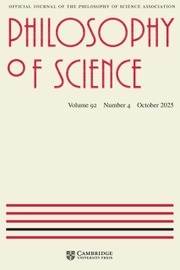Crossref Citations
This article has been cited by the following publications. This list is generated based on data provided by
Crossref.
Batterman, Robert W.
2003.
Falling cats, parallel parking, and polarized light.
Studies in History and Philosophy of Science Part B: Studies in History and Philosophy of Modern Physics,
Vol. 34,
Issue. 4,
p.
527.
Belot, Gordon
2003.
Symmetry and gauge freedom.
Studies in History and Philosophy of Science Part B: Studies in History and Philosophy of Modern Physics,
Vol. 34,
Issue. 2,
p.
189.
Bartels, Andreas
Lyre, Holger
and
Esfeld, Michael
2004.
Holism in the philosophy of physics: an introduction.
Studies in History and Philosophy of Science Part B: Studies in History and Philosophy of Modern Physics,
Vol. 35,
Issue. 4,
p.
597.
Lyre, Holger
2004.
Holism and structuralism in U(1) gauge theory.
Studies in History and Philosophy of Science Part B: Studies in History and Philosophy of Modern Physics,
Vol. 35,
Issue. 4,
p.
643.
Healey, Richard
2004.
Gauge theories and holisms.
Studies in History and Philosophy of Science Part B: Studies in History and Philosophy of Modern Physics,
Vol. 35,
Issue. 4,
p.
619.
Healey, Richard
2006.
Physical Theory and its Interpretation.
Vol. 72,
Issue. ,
p.
143.
Mattingly, James
2006.
Which gauge matters?.
Studies in History and Philosophy of Science Part B: Studies in History and Philosophy of Modern Physics,
Vol. 37,
Issue. 2,
p.
243.
Lyre, Holger
2008.
Does the Higgs Mechanism Exist?.
International Studies in the Philosophy of Science,
Vol. 22,
Issue. 2,
p.
119.
Guay, Alexandre
2008.
A partial elucidation of the gauge principle.
Studies in History and Philosophy of Science Part B: Studies in History and Philosophy of Modern Physics,
Vol. 39,
Issue. 2,
p.
346.
Anderson, Ronald
and
Joshi, G.C.
2008.
Interpreting mathematics in physics: Charting the applications of SU(2) in 20th century physics.
Chaos, Solitons & Fractals,
Vol. 36,
Issue. 2,
p.
397.
Lyre, Holger
2009.
Compendium of Quantum Physics.
p.
248.
Lyre, Holger
2009.
Compendium of Quantum Physics.
p.
1.
Muntean, Ioan
2012.
EPSA Philosophy of Science: Amsterdam 2009.
p.
239.
Afriat, Alexander
2013.
Weyl’s Gauge Argument.
Foundations of Physics,
Vol. 43,
Issue. 5,
p.
699.
Healey, Richard
2013.
Making space for fundamentals.
Metascience,
Vol. 22,
Issue. 3,
p.
561.
Russell, Jeffrey Sanford
2014.
On Where Things Could Be.
Philosophy of Science,
Vol. 81,
Issue. 1,
p.
60.
Stachel, John
2014.
The Hole Argument and Some Physical and Philosophical Implications.
Living Reviews in Relativity,
Vol. 17,
Issue. 1,
Shech, Elay
2015.
Two Approaches to Fractional Statistics in the Quantum Hall Effect: Idealizations and the Curious Case of the Anyon.
Foundations of Physics,
Vol. 45,
Issue. 9,
p.
1063.
Weatherall, James Owen
2016.
Fiber bundles, Yang–Mills theory, and general relativity.
Synthese,
Vol. 193,
Issue. 8,
p.
2389.
Huggett, Nick
2017.
Target space ≠ space.
Studies in History and Philosophy of Science Part B: Studies in History and Philosophy of Modern Physics,
Vol. 59,
Issue. ,
p.
81.

